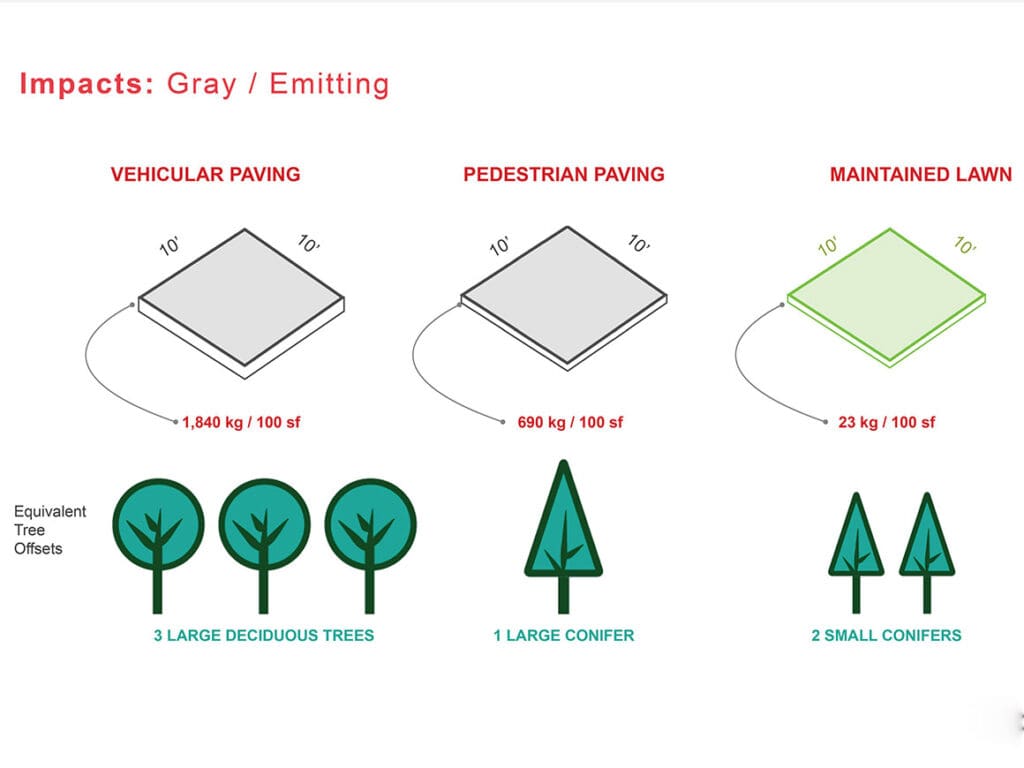Parks and open spaces: key players in climate change mitigation

Urban environments are significant contributors to carbon emissions. How can we leverage urban parks, green spaces, streetscapes, and plazas to sequester carbon and actively combat climate change?
In 2019, Pamela Conrad of CMG Landscape Architecture introduced Pathfinder, a web-based tool designed to assist landscape architects, architects, and engineers in enhancing their projects’ performance toward achieving carbon neutrality. This initiative stemmed from the Climate Positive Design Challenge, which urges projects like parks, gardens, campuses, and hospitality venues to become carbon positive within five years of design and construction, with plazas and streetscapes aiming for climate positivity by 2030. Currently, many of these projects emit more carbon than they sequester. However, if the challenge is met, green open spaces could potentially sequester a gigaton of carbon emitted in cities by 2050, significantly mitigating the climate crisis.
Pathfinder serves as an effective design tool, enabling the evaluation of various site design options and emphasizing the critical role of landscapes in carbon sequestration. For projects with buildings, Pathfinder facilitates the demonstration of landscapes’ substantial contribution to overarching decarbonization goals.
Trees and plants are known for sequestering and storing carbon in their wood, with the added benefit of increasing carbon sequestration as they mature. Urban parks and streetscapes, already valued for their recreational and social attributes, play a crucial role in not only sequestering carbon but also mitigating climate change.
Pathfinder goes beyond calculating the sequestration potential of landscapes. It also identifies opportunities to fine-tune landscape design by adjusting materials such as pavers, concrete, and lawn areas, all of which influence the speed at which carbon neutrality can be achieved. Objective comparisons of design options through the lens of carbon impact underscore the importance of preserving vegetated open spaces and planting trees.
However, not all green spaces are equal in their carbon sequestration capacity. Evaluating trees for their environmental services is essential, with larger trees, particularly conifers in the Pacific Northwest, sequestering more carbon. Green infrastructure is sometimes overlooked as a carbon sequestration tool, but designed elements like rain gardens provide particularly high carbon sequestration potential. And wetlands, though they don’t offer the same occupiable space as some other land types, are not only crucial ecosystems, but can also sequester carbon at rates almost as high as mature forests. Turf lawns, on the other hand, emit carbon due to maintenance practices. Replacing traditional lawn areas with no-mow options or shrubs, along with using electric maintenance equipment, significantly enhances sequestration performance.
In plazas, where hardscape is often necessary, integrating shrubs and large trees can expedite reaching carbon positivity by five-10 years, depending on plaza size, materials, and maintenance practices. Utilizing alternatives like decomposed granite instead of pavers or concrete slabs further aids in carbon sequestration.
Berger Partnership has been utilizing the Pathfinder tool since its beta version and has applied it to over ten projects to date. Notably, it played a pivotal role in the Everett Housing Authority Park District project, an innovative affordable housing endeavor that incorporates park space to foster a new community in the existing Delta neighborhood.
Through collaborative efforts with clients and design team members, Pathfinder’s carbon calculations demonstrated the positive impact of preserving substantial open space in achieving carbon neutrality. By exploring multiple design options with Pathfinder, the team reduced the timeline for carbon neutrality from 91 years to 16 years, primarily by opting for denser housing layouts, allowing more room for trees, shrubs, and green space.
Parks, open spaces, and streetscapes offer numerous benefits, including improved mental health, physical activity, shade provision, and habitat creation. Recognizing them as measurable climate solutions can inspire us to enhance or rewild our urban spaces. With widespread adoption by the AEC industry and government bodies, we can collectively address the climate impacts of carbon emissions. Pathfinder, available at https://app.climatepositivedesign.com, stands as a valuable resource in this endeavor.